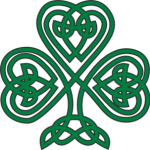An tSeamróg (The Shamrock) Posted by róislín on Mar 10, 2012 in Irish Language
(le Róislín)
Today’s theme, as we approach Lá Fhéile Pádraig, is “What exactly is a shamrock?” The “Naturalist’s Almanac,” by Gale Lawrence, refers to eight contenders, of which five are actually types of clover (seamair), and one is wood sorrel (seamsóg); the site is: http://www.naturalistsalmanac.com/0317stpat.html. She doesn’t specify the other two contenders, so that will have to be ábhar blag eile.
Here are the forms of the three key words for today’s blog: seamróg, seamair, seamsóg
1. an tseamróg, the shamrock (“t” prefixed before the “s” because “seamróg” is feminine and singular)
na seamróige, of the shamrock
na seamróga, the shamrocks
na seamróg, of the shamrocks (síolta na seamróg, mar shampla, the seeds of the shamrocks)
2. an tseamair, the clover
na seimre, of the clover (dath na seimre, mar shampla)
na seamra, the clovers
na seamar, of the clovers
3. an tseamsóg, the wood-sorrel; “seamsóg,” or perhaps a homonym of it, also means “worthless thing” but it’s unclear to me how the two are actually related, cf. Ní fiú seamsóg é, it’s worthless (lit. it isn’t worth a “seamsóg”). “Seamsóg” can also mean a “small nail” or a “peg.”
na seamsóige, of the wood-sorrel (blas na seamsóige, mar shampla)
na seamsóga, the wood-sorrels (I feel inclined to say “the wood-sorrel” for plural also, but I see both online and I guess “sorrels” is more clearly plural. Barúlacha?)
na seamsóg, of the wood-sorrel(s)
Are seamróga edible? Lawrence says she tried eating clover leaves and found that they didn’t taste very good to humans, though they are, of course, favored by ba (cows). She says she also tried eating wood-sorrel (Oxalis) which she found to be “an-bhlasta” (quite tasty). Of course she didn’t say it in Irish, I’m just taking blogic (?) license and putting words into her mouth.
This question could be especially important, perhaps, if you are considering a “drowned shamrock,” that is, one that has been saturated in whiskey while you were drinking a “Pota Pádraig” (St. Patrick’s Pot). Could you drink the shamrock down, or is it best to follow the tradition of throwing “an tseamróg fhliuch” over do ghualainn chlé (your left shoulder). An ndéanann tú féin sin?
Now here’s some herbal food for thought, with a word-match game, to test your shamrock/clover/wood sorrel knowledge. Freagraí thíos, mar is gnách.
| 1. seamrach | 2. seamair Mhuire | 3. seamrógach | 4. seamair choille | 5. seamróg ghéar |
| a. covered with shamrocks | b. another name for wood-sorrel | c. four-leaved shamrock | d. yet another name for wood-sorrel | e. covered with clover |
Cad a shíleann tusa faoin tseamróg? Seamair nó seamsóg-et-al.? Nó rud éigin eile? Scríobh isteach má tá barúil agat, le do thoil. SGF, Róislín
Freagraí: 1. seamrach, e. covered with clover; 2. seamair Mhuire, c. four-leaved shamrock (lit. Mary’s clover) — amazingly “seamair Mhuire” can also mean “female pimpernel,” “yellow wood loose-strife,” “mouse-ear,” and “chickweed! 3. seamrógach, a. covered with shamrocks; 4. seamair choille, b.(d.) wood-sorrel; 5. seamróg ghéar, d.(b.) wood-sorrel. Still another word for “wood-sorrel” uait? Fadhb ar bith: seamsán, None of this to be mistaken for other types of sorrel, generally known as “samhadh” [SOW-uh], such as “Irish sorrel” (samhadh gaelach), “French sorrel” (samhadh gallda), upright yellow-sorrel (seamsóg ghallda), and “procumbent yellow-sorrel” (seamsóg bhuí). As you might have noticed, neither of the last two phrases actually specifies “upright” vs. “procumbent.” I guess we just have to know our sorrels by sight, or by gut instinct. Does that make us men (or women) of constant sorrels? (ag tumadh san uisce, nó faoi mo dheasc, leis an fhírinne a dhéanamh!)

Build vocabulary, practice pronunciation, and more with Transparent Language Online. Available anytime, anywhere, on any device.





Comments:
Mise Áine:
Bain sult as an bhFéile, a Róislín!
róislín:
@Mise Áine GRMA, a Áine, agus bain thusa sult as freisin!